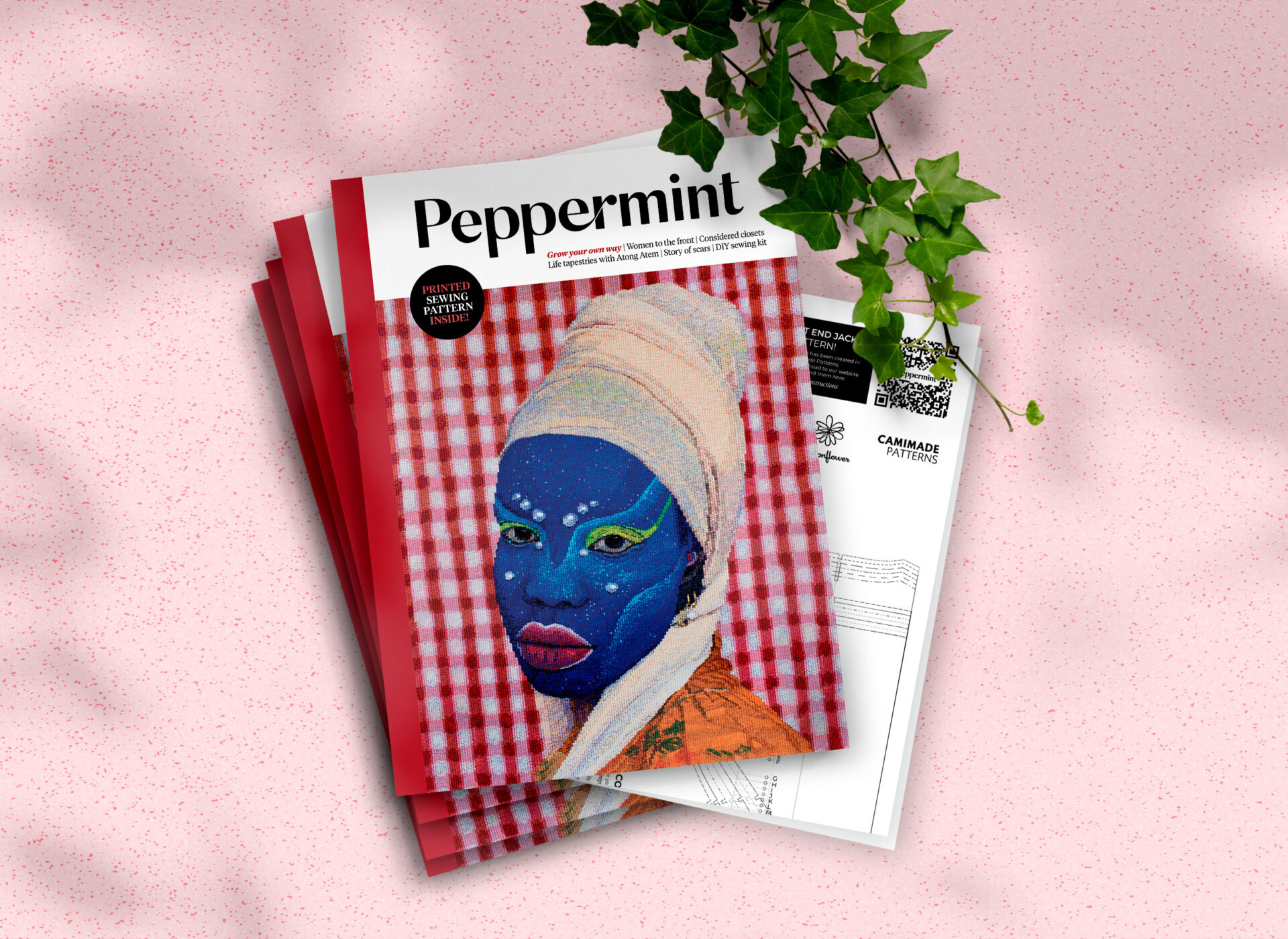
Ready, Set, Grow! Our Spring Issue is Ripe for the Picking… On Sale Now!
Like a seedling seeking the sun, soak up the warm glow of our beautiful and bright spring beauty, which is making its way to a shelf near you…
Grow you good thing and dig into all the usual Pepperminty fun of these gorgeous pages – made with heart and happiness. First stop: pick your jaw up off the floor after marvelling at our stunner of a cover (it’s a tapestry!). Woven by Pamela Joyce of the Australian Tapestry Workshop and based on the incredible self-portraiture work of Naarm-based South Sudanese artist Atong Atem, this textural beauty (along with much of Atong’s work) explores the convergence between politics, arts and craft – something that is endlessly inspiring to us.
Proving that there’s no intersection she can’t write about, encyclopaedic sewist extraordinaire Bonnie Liston turns her discerning feminist lens onto the injustice of sewn-in pockets. Journalist and author Gina Rushton speaks with powerhouse Daile Kelleher as she – at the helm of Children by Choice – continues to fight for reproductive justice. Putting phenomenal women right to the front, we ask some of Australia’s changemaking women about the women who made them to celebrate the power of womanhood and lifting women up.
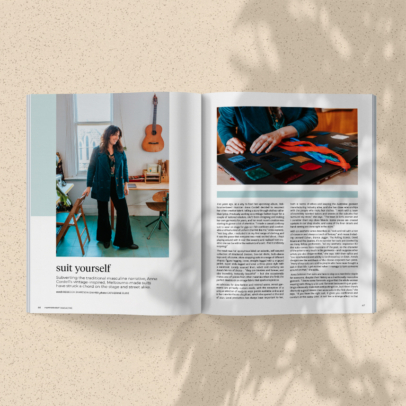
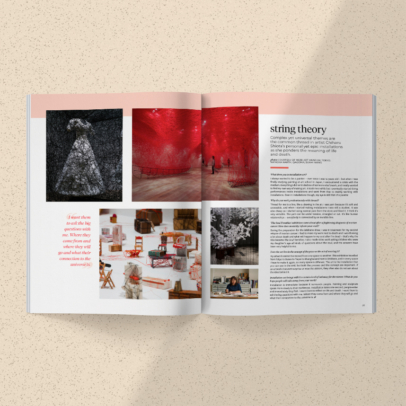
We go behind the seams with uber-creative, multi-hyphenate musician, suit maven and mum of five Anna Cordell in her Northcote shopfront, from where her coveted suits are taking over stages and streets all over the world! Photographer Jarrad Seng goes under the skin to explore the meaning of scars; Japanese installation artist Chiharu Shiota explores the meaning of life and death, asking what makes a soul; photographer and writer Sarah Collins finds that charm springs eternal in Victoria’s spa country, Daylesford; we head to Darwin to visit social enterprise and gallery Aboriginal Bush Traders; and we chat with the artistic director of Darwin Aboriginal Art Fair, Shilo McNamee, about the enduring power of art festivals.
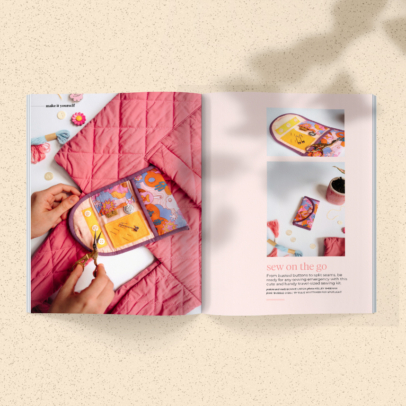
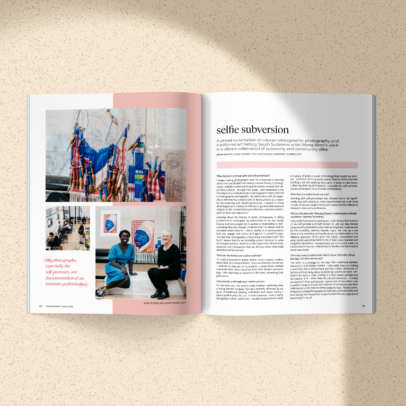
Continuing our love affair with all things craft, sewing and making your own, this issue’s pages hold our ever-popular printed sewing pattern (spoiler alert: it’s a trans-seasonal jacket with endless wearability!), a DIY macrame pot-plant holder and a scrap-busting sewing kit pattern – designed by Bonnie!
And finally, in a secret theme that emerged as we were putting the pages together, the transformative potential of getting your hands in the dirt – from farming to gardening – looms large in this issue. Nicola Harvey delves into becoming a living oxymoron: a farming climate activist, in an extract from her book Farm; journalist Koren Helbig discusses community gardening as both wellbeing tool and food security solution; and intrepid but accidental funny-vegetable gardener Claudia Hooper expounds the benefits of letting your garden grow in weird and wonderful ways.
And, once again, the FREE printed pattern (hurrah!) is nestled somewhere in your lovely issue so you can ready, set, sew, too!
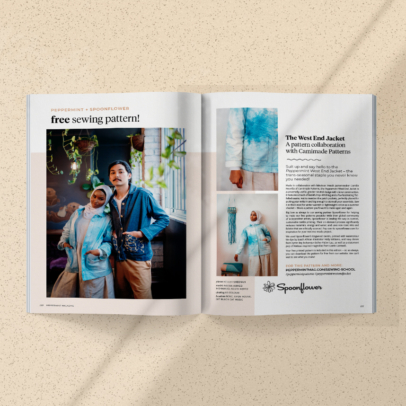
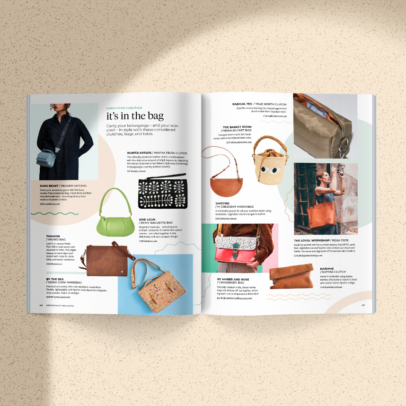
Give your to-read pile a tszujing by heading to a stockist today or purchase a copy from our shop (and for the digital version, head here).
Take a peek inside this issue!
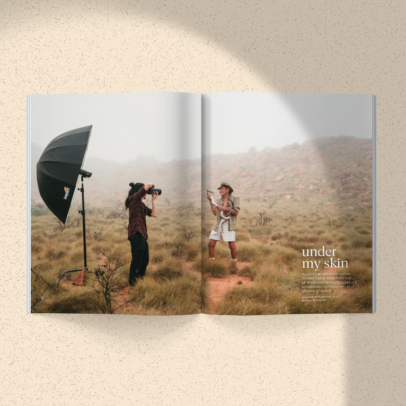
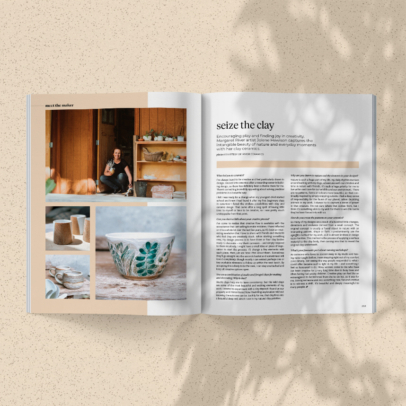
‘UNDER MY SKIN’ Australian photographer Jarrad Seng taps into our shared humanity to capture the power, symbolism and stories of scars.
I’ve always believed that every scar has a story.
And when I think of my own – whether big or small, whether from a surgery, from the time I fell over giving my little sister a piggyback or battle wounds from my short-lived time on Survivor – they each mark a vivid memory from my past. I wanted to explore this idea further. What untold stories of resilience, strength and trauma lie beneath the scars we all hold? What do they represent to people who have been through life-changing experiences and how has that perspective changed over time?
Scars, or trauma in general, can be quite uncomfortable or difficult to talk about. The power of photography is that I was able to talk about these human experiences with people in an intimate, unique and powerful way.
The process became quite poignant for me and the subject. I came into the project trying to make it as swift and easy as possible for everyone – with the mindset that I wanted to take up as little of their time as possible. But many of those I photographed thanked me afterwards. For them, the portrait was a chance for them to tell their story, to be heard. To talk about what happened in a safe and empowering way. There was a shared vulnerability between us – one that wouldn’t have happened without the camera in hand.
‘GARDEN PARTY’ Mishaps and misadventures are all part of the gourd-filled game of gardening but there’s something to be said about the slow, meditative art of watching things grow? Words by Claudia Hooper.
Being entertained by watching something grow may sound a little sad, but after two years of lockdowns, the tromboncino is a real performer. Indeed, there’s a lot of joy to be found in the slowness of gardening – appreciating the daily and seasonal changes that take place even in a small outdoor space. The health and wellbeing benefits are well established. This type of contemplative activity, out among the greenery, and working on something genuinely productive, definitely boosts my mood between Zoom calls.
…
I’d watched many a schlong-like fruit shoot out from the vine in preparation for pollination but nearly all had withered and died. Zucchini plants produce both male and female flowers, and the female fruiting flowers need to be pollinated so that the fruit continues to grow. The tromboncino looks stunning when its female flowers open, dangling gracefully like a primrose-coloured, art nouveau lamp. Yet, throughout the season, I’d encountered decidedly frigid plants that didn’t, nay wouldn’t, open at the same time. Frequently, there’d be an abundance of male flowers but no females around and vice versa.
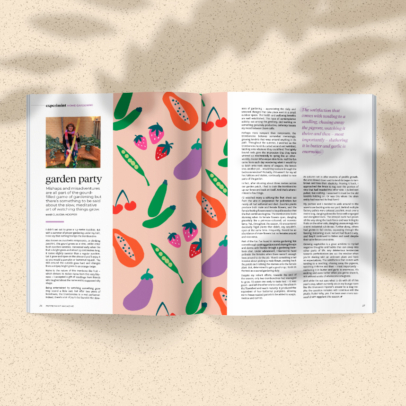
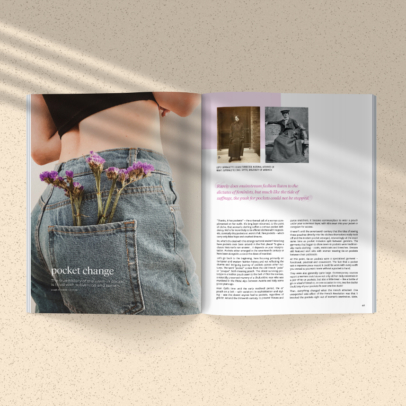
‘POCKET CHANGE’ The true history of the sewn-in pocket is filled with subversion and sexism. Words by Bonnie Liston.
“Thanks, it has pockets!” – the universal call of a woman complimented on her outfit. It’s long been observed, to the point of cliche, that women’s clothing suffers a serious pocket deficiency. We’re far more likely to be offered clothes with no pockets, comically tiny pockets or, worst of all, fake pockets – which carry only false hope and crushed dreams.
So, what’s the deal with this strange sartorial sexism? How long have pockets even been around in the first place? To give a classic historian’s non-answer… it depends on your interpretation. Pockets either emerged in the seventeenth century or have been alongside us since the dawn of mankind.
…
But why? Why do the fortunes of women’s pockets wax and wane so dramatically while men’s remain? The gendered baggage that pockets carry – or don’t if you’re a woman – is quite complex. Some suggest privacy as a factor – if women have a personal space of concealment, it’s hard to monitor or control what they might use it for. Others focus on autonomy – the more essentials you can carry on your person, the easier it is to negotiate public spaces and travel freely on your own.
The most obvious answer – and the one that explains the modern pocket drought that prevails even now that women have largely earned the freedom to hold their own things and travel where they will – is objectification.
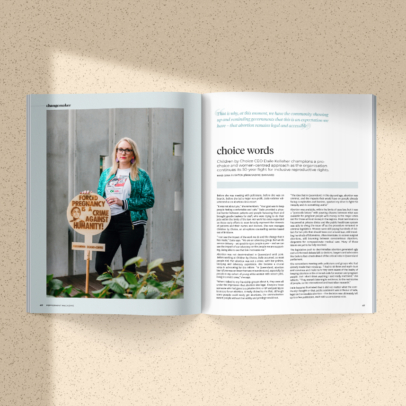
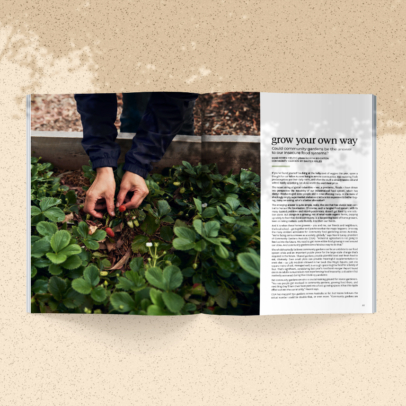
‘CHOICE WORDS’ Children by Choice CEO Daile Kelleher champions a pro-choice and women-centred approach as the organisation continues its 50-year fight for inclusive reproductive rights. Words by Gina Rushton.
“It was not about you,” she remembers. “Your goal was to keep people feeling comfortable and safe.” Daile provided a physical barrier between patients and people harassing them and brought goodie baskets for staff, who were trying to do their jobs within the limits of the law. Her work has since expanded on those early efforts to more broadly represent the interests of patients and their nurses and doctors. She now manages Children by Choice, an all-options counselling service based out of Brisbane.
“I can see the impact of the work we do and the change that it has made,” Daile says. “We are an advocacy group, but we do service delivery – we speak to 1500 people a year – and we can see the impact of our advocacy on the people we are supporting. Being able to see that link motivates me.”
Abortion was not decriminalised in Queensland until 2018. Before working at Children by Choice, Daile assumed, as most people did, that abortion was not a crime. With her politics, lobbying and advocacy experience, she became a crucial voice in advocating for the reform. “In Queensland, abortion law reform was an issue that was misunderstood, especially by people in my cohort of young white women with secure jobs, living in a metro area,” she says.
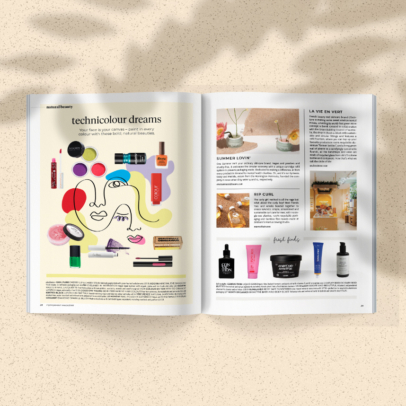
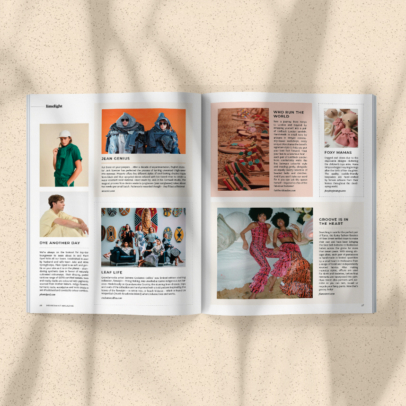
‘STACK THE DECK AGAINST DISASTER’ If calamity befalls, how do you pick yourself up and try again? With a little help from your friends and these hard-won insights…
The disaster is over, but what happens now? Moving on after great upheaval, be it flood or bushfire, cyclone or tsunami, can feel like a journey into the unknown – isolating, overwhelming and uncharted.
“With climate change, the number and intensity of disasters is increasing and we realised that helping one person, one community, one disaster at a time, was no longer enough. We felt compelled to create an ‘expert in a box’ to help more people recover, feel more in control and find clarity in the chaos,” says Elizabeth McNaughton. Director of New Zealand business Hummingly, creator of Cards for Calamity, she and her co-founder Jolie Wills have worked in disasters around the world for more than two decades gathering wisdom from over 100 crisis leaders, feedback from thousands of disaster survivors and scientific insights from their background in cognitive psychology. They share a passion to prepare the world to do disruption, stress and uncertainty well.
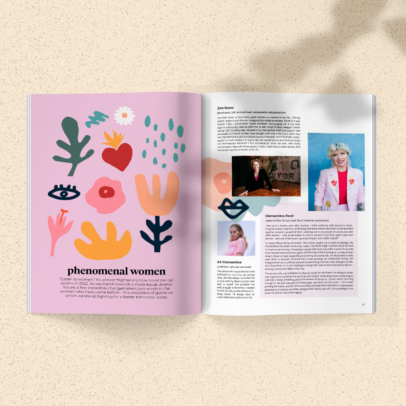

‘PHENOMENAL WOMEN’ “Listen to women.” It’s almost frightening how novel the call seems in 2022. As we march towards a more equal, diverse future, a few incredible changemakers pen words to the women who have come before – the shoulders of giants on which we stand, fighting for a better tomorrow, today.
Clementine Ford
Author of ‘How We Love’ and ‘Dear Clementine’ podcast host
I feel such a kinship with other women. I think solidarity with women is something we’ve been kept from embracing, because women who work in communities together present a powerful force. Learning not to be scared of community with other women – and, in particular, to not be scared of how that might make men see me – was one of the most important things I ever did for myself.
I’m truly influenced by all women. My mother taught me to seek knowledge. My friends teach me what community means. My fellow single mothers teach me how to be proud and strong. The women I speak with every day in the course of my work show me just how much love, grace and ferocity there is among us. Loving women doesn’t have to mean supporting everything all women do. It’s important to hold each other to account, because this is how we keep our community strong. But loving women as a political practice is something that has truly changed my life, and I hope that I’m in turn helping to change the lives of other women by demonstrating that love for them every day. The women who came before me planted seeds for the forest I’m sitting in today. I am inspired to continue that work by nurturing it, expanding it and continuing to cultivate a living, breathing place for women to thrive in.
I know I won’t live long enough to see just how wild the forest gets, but that’s not the point – it’s to keep growing the forest, and for all of us to keep passing down the tools to subsequent generations of women who’ll be charged with taking care of it. It’s a privilege to be a part of such an important legacy.


